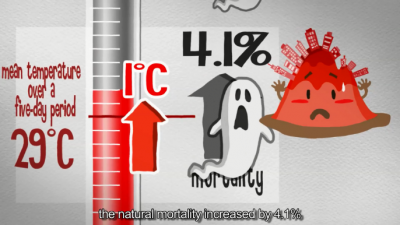Under the influence of the severe tropical storm Hato, the Hong Kong Observatory recorded the highest ever temperature of 36.6°C on 22 August since records began in 1884. The temperature in Wetland Park was even higher, reaching an astounding 39°C. High temperatures not only bring discomfort, but also raise the fatalities caused by cardiovascular and respiratory diseases.
The Collaborating Centre for Oxford University and The Chinese University of Hong Kong (CUHK) for Disaster and Medical Humanitarian Response (CCOUC) has been dedicated to climate change and health research. Because extreme weather has occurred more frequently in recent years, CCOUC has translated its research findings into a video clip series, entitled “Between Extremes: Threatening Heat and Cold”, in support of the CUHK Faculty of Medicine. The video clips are presented in lively and amusing animations to provide scientific evidence of climate change and its health impact to the public and encourage them to better prepare for and mitigate the adverse impact of extreme temperature events. The series also intends to disseminate information about disaster preparedness and healthy living at policy making and local community levels, and to raise urban dwellers’ awareness of climate change, environment and health outcomes.
The video clip series covers five themes, namely, 1) Death, 2) Urban Heat Island Effect, 3) Hospital Admissions, 4) Help-seeking and 5) Health Co-benefits. (The abstracts of video clips are attached with the press release.)
The Chinese and English versions of the video series are being uploaded online (http://www.ccouc.ox.ac.uk/video) . They will also be disseminated to various relevant government departments (including the Hong Kong Observatory, Education Bureau, Food and Health Bureau, Environment Bureau, etc.), relevant consultative bodies, District Councils, NGOs and secondary schools. The video will also be played in the Jockey Club Museum of Climate Change CUHK and at various international conferences.
 |
 |
Abstracts of the “Between Extremes: Threatening Heat and Cold” video clip series
 |
In the hot season, at a daily mean temperature of 28.2°C, every 1°C increase was associated with an estimated 1.8% increase in mortality. Cardiovascular and respiratory infection related deaths were most connected to high temperature effects. During our research period (1998-2006), more than one-fifth of that time saw a daily mean temperature higher than the threshold of 28.2°C. In the cold season, when there was a 1°C drop in daily mean temperature, the subsequent three weeks had a 3.8% cumulative increase in mortality. Older people were particularly vulnerable. |
 |
With rapid urban development, the densely built high-rises block the airflow and trap the heat emissions from vehicles and industrial activities, while building materials, including concrete, absorb and retain some of the heat. These contribute to the temperature rise in the urban area. When the urban cooling rates are slower than rural areas, the Urban Heat Island effect develops. In areas of severe Urban Heat Island effect, when the mean temperature over a five-day period exceeded 29°C, the natural mortality increased by 4.1% with every 1°C increase. |
 |
During the hot season, when the daily mean temperature exceeded the threshold of 29°C, every 1°C increased hospital admissions by 4.5%. During the cold season, for every 1°C drop, admissions increased by 1.4%. Some diseases have significant association with extreme weather events, including asthma, hand foot and mouth disease, stroke, acute myocardial infarction and heart failure. When extreme temperatures come, as well as medical personnel, other public service units should provide a timely and adequate response for high risk groups in the community. |
 |
When the highest temperature exceeded 32°C, the number of emergency help calls increased significantly along with the temperature rise; almost half of the calls reported symptoms of dizziness, shortness of breath and general pain. Females were more sensitive to high temperature. A territory-wide, large-scale telephone survey conducted by CCOUC during the 2016 cold spell found that amongst the 1,017 participants, 683 (67.2%) reported that the cold spell brought physical discomfort. However, only 134 (13.2%) respondents had sought medical help, among whom 17 (12.7%) bought medicine without seeing doctors. Musculoskeletal pain (42.3%) was the most common symptoms; others were respiratory system symptoms (23.0%) and cardiovascular system symptoms (6.9%). |
 |
Carbon-reducing behaviour, like walking, cycling and cutting meat consumption, generates health co-benefits. Our study indicated that a large proportion of the older age groups practised carbon-reducing behaviour, contrary to the general conception that the younger generation adopts such environmental behaviour more readily. Using less packaging and shopping bags was the most common carbon-reducing behaviour, and was practised by 70.1% of interviewees every day. Only 3.5% of interviewees were vegetarian and about half (49%) of meat eaters, especially males, had never thought of eating vegetables only for at least one day a week. |